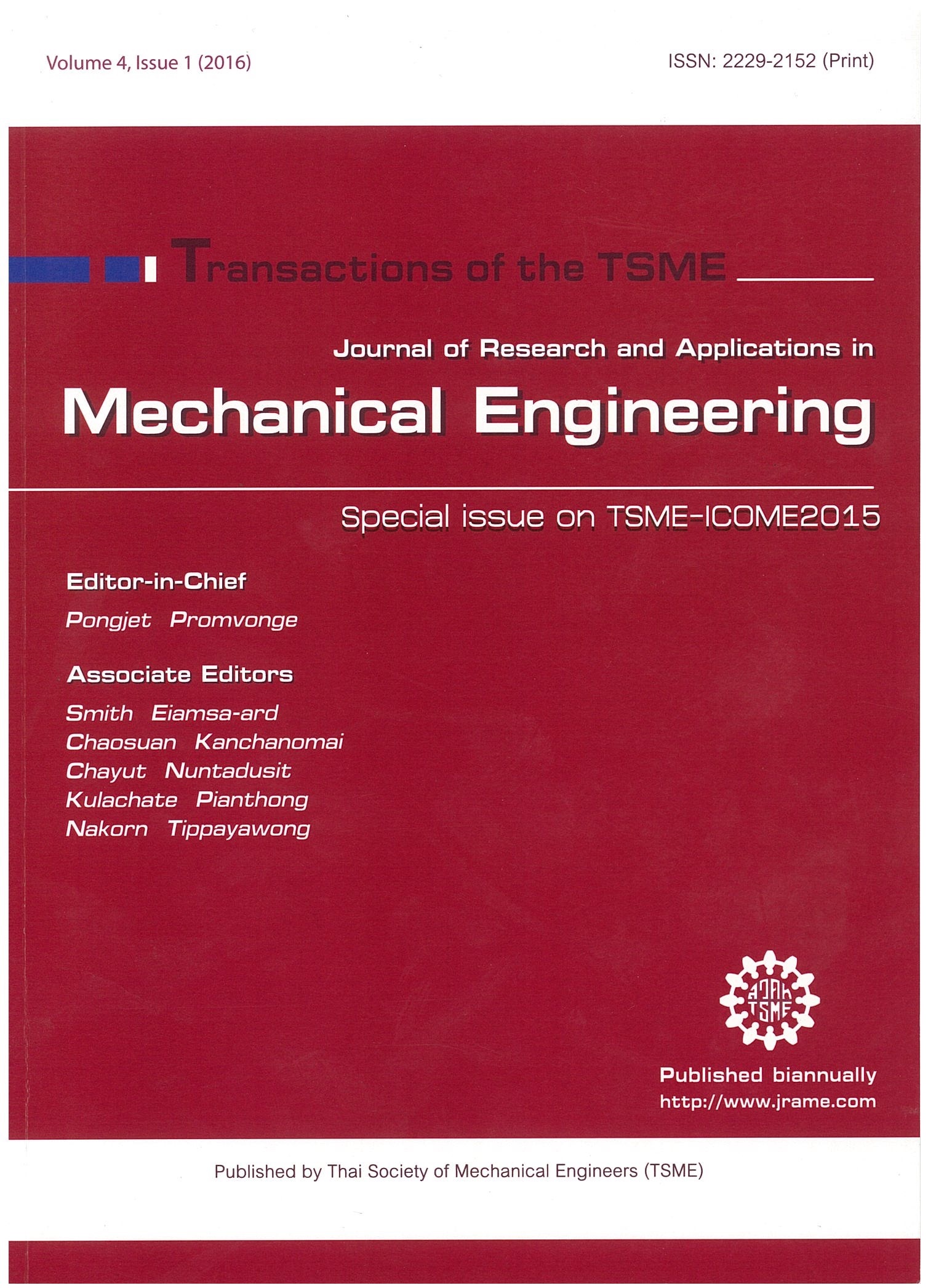Surrounding gas pressure and temperature dependence of the auto-ignition phenomenon for ethanol-dietyl ether blended fuels
Main Article Content
Abstract
This study deals with the development of controlled-ignition technology for high performance compression ignition alcohol engines. The objective of this study is quantitative evaluation of main factors that influence auto-ignition of an alcohol spray. The quantitative evaluation that can be finally as the database in a form of 3D-mapping of ignition delay is now in progress. This paper focuses on the effects of surrounding gas pressure and temperature on auto-ignition. Spray mixture formation and auto-ignition phenomena of Ethanol-Diethyl ether blended fuels were visualized by shadowgraph method and images were recorded with high-speed camera (8213 fps). A large constant volume electrical heating chamber was used in the visualization tests. The results as the first step of 3D-mapping of ignition delay showed that the autoignition of Ethanol-Diethyl ether blended fuels was strongly influenced by surrounding gas pressure under relatively lower temperature condition (750K). In higher temperature condition (800K), surrounding gas pressure dependence of the ignition delay was smaller than those of the 750K case. This paper indicates that the engine control logic can be drawn and the high performance CI engines flexible for any kinds of bio-fuels can be developed when the database as 3D-mapping of the ignition delay is completed.
Article Details
This work is licensed under a Creative Commons Attribution-NonCommercial-ShareAlike 4.0 International License.
References
[2] Niemi, S. and Pitkanen, J. Development of a turbocharged and inter-cooled spark-assisted direct-injection ethanol engine, 1993, Proc. of 20th CIMAC, D14.
[3] Ramesh, A., Nagalingam, B. and Gopalakrishnan, K.V. Investigation on the design and performance of two types of hot surface ignition engines, 1992, SAE-921632.
[4] Simonsen, H. and Chomiak, J. Testing and evaluation of ignition improvers for ethanol in a DI diesel engine, 1995, SAE Technical Paper 952512.
[5] Saitoh, H. and Uchida, K. On the main factors governing auto-ignition phenomenon of alcohol spray: A study from the view point of fuel properties, SAE Int. J. Fuels and Lubricants, Vol. 2(1), 2009, pp. 911-920.
[6] Munsin, R., Laoonual, Y., et al. Investigation of effects of ignition improvers on ignition delay time of ethanol combustion with rapid compression and expansion machine, SAE Technical Paper 2012-01-0854.
[7] Munsin, R., Laoonual, Y., et al. Effect of glycerol ethoxylate as an ignition improver on injection and combustion characteristics of hydrous ethanol under CI engine condition, Journal of Energy Conversion and Management, Vol. 98(1), 2015, pp. 282-289.
[8] H. Saitoh and K. Uchida, Effect of surrounding gas oxygen content on the spray mixture formation and auto-ignition phenomenon for ethanol-diethyl ether blended fuels, SAE Paper No.2013-01-0076.
[9] H. Saitoh and K. Uchida, A study on the conditions of controlled ignition for the fuels with poor auto-ignition quality, Journal of Flow Visualization and Image Processing, Special Issue of PSFVIP-9, 2014, pp. 1-16.
[10] Saitoh, H., Uchida, K. and Tateishi, M. Effects of heat supply methods into a spray of alcohol fuels on ignition and combustion characteristics in a small DI alcohol engine, Proc. CD of 30th FISITA World Automotive Congress, 2004, Paper F2004V222.
[11] Saitoh, H., Uchida, K. and Tateishi, M. Effect of hot EGR on combustion and emission characteristics in a diesel type alcohol engine, 2004, 24th CIMAC World Congress on Combustion Engine Technology, Paper No.162.
[12] Uchida, K., Saitoh, H. and Tateishi, M. Combined effects of fuel injection timing and hot EGR on ignition, combustion and thermal efficiency in a small DI alcohol engine, 13th International Pacific Conference on Automotive Engineering, 2005, Paper 41.
[13] Saitoh, H. and Uchida, K. Difference of spray mixture formation between gas oil and ethanol in a constant volume electrical heating chamber, SAE Technical Paper 2007-01-3617.
[14] Siebers, D.L. and Edwards, C.F. Auto-Ignition of methanol and ethanol sprays under diesel engine conditions, 1987, SAE Technical Paper SAE-870588.



